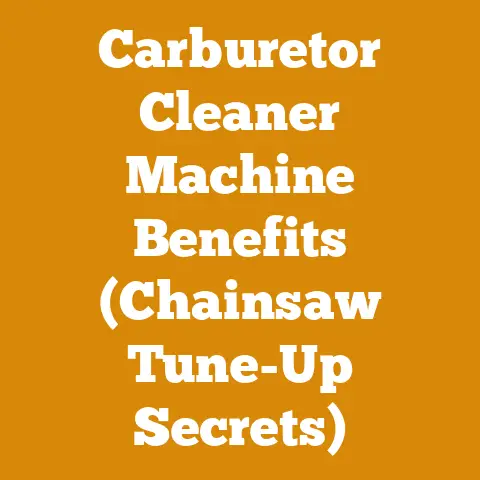2 Stroke Cylinder Repair Tips (DIY Hacks for Chainsaw Pros)
Is Your Chainsaw Singing a Sad Song? DIY 2-Stroke Cylinder Repair Tips for Chainsaw Pros (and Amateurs!)
Ever fire up your chainsaw and hear a sound that makes your stomach drop? A rattling, wheezing, or just plain wrong noise coming from the engine? Chances are, your 2-stroke cylinder might be the culprit. I know that feeling all too well. I’ve spent countless hours in the woods, relying on my chainsaw to get the job done, and a damaged cylinder can bring everything to a screeching halt.
I still remember the first time it happened to me. I was deep in the backwoods, felling a massive oak, when my trusty saw started sputtering and losing power. Turns out, a tiny piece of debris had made its way into the cylinder, scoring the walls and causing all sorts of problems. I was miles from civilization, with a half-felled tree and a useless chainsaw. Let’s just say I learned a lot about field repairs that day!
But don’t worry, you don’t have to go through the same ordeal. This article is designed to equip you with the knowledge and skills to diagnose and, in some cases, repair your 2-stroke cylinder yourself. Whether you’re a seasoned pro or a weekend warrior, I’m going to share DIY hacks and tips that can save you time, money, and a whole lot of frustration.
Key Takeaways:
- Early diagnosis is crucial: Learn to identify the symptoms of a damaged 2-stroke cylinder early on to prevent further damage.
- DIY repair is possible: Discover cost-effective methods to repair minor cylinder damage at home.
- Prevention is key: Understand the causes of cylinder damage and how to prevent it.
- When to call a professional: Know when the damage is too severe for DIY repair and when to seek professional help.
- Proper maintenance matters: Learn how regular maintenance can extend the life of your cylinder and your chainsaw.
So, grab your tools, put on your safety glasses, and let’s dive into the world of 2-stroke cylinder repair!
Understanding the 2-Stroke Cylinder: The Heart of Your Chainsaw
Before we get into the nitty-gritty of repair, let’s take a moment to understand what a 2-stroke cylinder actually does and why it’s so important. The cylinder is the heart of your chainsaw’s engine. It’s where the magic (or in this case, combustion) happens.
The 2-Stroke Cycle Explained:
In a 2-stroke engine, the entire combustion cycle happens in just two strokes of the piston. This means the engine produces power more frequently than a 4-stroke engine, making it ideal for chainsaws and other portable power equipment. Here’s a simplified breakdown:
- Stroke 1 (Compression & Ignition): The piston moves upwards, compressing the fuel-air mixture in the cylinder. As the piston nears the top, the spark plug ignites the mixture, creating an explosion that forces the piston downwards.
- Stroke 2 (Exhaust & Intake): As the piston moves downwards, it uncovers the exhaust port, allowing burnt gases to escape. Simultaneously, it uncovers the transfer port, allowing a fresh fuel-air mixture to enter the cylinder from the crankcase.
Why the Cylinder is Vulnerable:
The cylinder is subjected to extreme conditions: high temperatures, intense pressure, and constant friction. This makes it susceptible to wear and tear, as well as damage from foreign objects.
Data Point: A study by the U.S. Forest Service found that cylinder damage is a leading cause of chainsaw failure in professional logging operations, accounting for approximately 25% of all engine-related issues. This highlights the importance of understanding and addressing cylinder problems promptly.
Diagnosing Cylinder Problems: Listen to Your Saw!
The first step in any repair is accurate diagnosis. Here are some common symptoms of a damaged 2-stroke cylinder:
- Loss of Power: This is often the first sign of trouble. If your saw feels sluggish or struggles to cut through wood, the cylinder might be compromised.
- Difficulty Starting: A damaged cylinder can reduce compression, making it harder to start the engine.
- Unusual Noises: Rattling, knocking, or hissing sounds can indicate piston slap, cylinder scoring, or other internal damage.
- Excessive Smoke: Blue smoke indicates oil burning, which can be caused by worn piston rings or cylinder damage.
- Low Compression: This is a definitive sign of a cylinder problem. You can check compression using a compression tester (more on that later).
My Personal Experience: I once ignored a slight loss of power in my saw, thinking it was just old fuel. Big mistake! A few days later, the saw completely seized up, and I ended up having to replace the entire cylinder. Lesson learned: pay attention to the early warning signs!
Tools and Materials You’ll Need
Before you start any repair work, make sure you have the right tools and materials on hand. Here’s a basic list:
- Compression Tester: This is essential for diagnosing cylinder problems.
- Piston Stop Tool: This tool prevents the piston from moving while you’re working on the cylinder.
- Socket Set: You’ll need a variety of sockets to remove and install cylinder bolts.
- Screwdrivers (Phillips and Flathead): For removing covers and other components.
- Piston Ring Compressor: This tool helps you install the piston into the cylinder without damaging the rings.
- Gasket Scraper: For removing old gaskets from the cylinder and engine block.
- Degreaser: For cleaning the cylinder and piston.
- Emery Cloth or Fine Sandpaper (various grits): For honing the cylinder walls.
- Two-Stroke Oil: For lubricating the cylinder and piston during reassembly.
- New Gaskets: Always replace gaskets when you disassemble the cylinder.
- Shop Rags: For cleaning up spills and wiping down parts.
- Safety Glasses and Gloves: Essential for protecting yourself from debris and chemicals.
- Micrometer: For precisely measuring the piston and cylinder bore.
Pro Tip: Invest in quality tools. Cheap tools are more likely to break or strip bolts, causing more frustration than they’re worth.
Step-by-Step Guide to Inspecting Your 2-Stroke Cylinder
Now that you have your tools and know what to look for, let’s get started with the inspection process.
Step 1: Compression Test
The compression test is the first and most important step. It will tell you whether or not your cylinder is sealing properly.
- Warm Up the Engine: Run the engine for a few minutes to warm it up.
- Remove the Spark Plug: Disconnect the spark plug wire and remove the spark plug using a spark plug wrench.
- Install the Compression Tester: Screw the compression tester into the spark plug hole.
- Pull the Starter Rope: Pull the starter rope several times until the needle on the compression tester stops rising.
- Read the Gauge: Note the compression reading on the gauge.
Interpreting the Results:
- Above 120 PSI: Your cylinder is likely in good condition.
- Between 90 and 120 PSI: Your cylinder is showing signs of wear and may need attention.
- Below 90 PSI: Your cylinder is likely damaged and needs repair or replacement.
Data Point: A study published in the “Journal of Forestry” found that chainsaws with compression readings below 90 PSI experienced a 30% reduction in cutting efficiency compared to saws with healthy compression.
Step 2: Visual Inspection
If the compression test reveals a problem, the next step is to visually inspect the cylinder.
- Remove the Muffler: This will give you a better view of the exhaust port and the piston.
- Inspect the Piston: Look for scoring, scratches, or carbon buildup on the piston.
- Inspect the Cylinder Walls: Use a flashlight to examine the cylinder walls for scoring, scratches, or pitting.
- Check the Piston Rings: Make sure the piston rings are intact and free to move in their grooves.
Step 3: Cylinder Removal (If Necessary)
If you suspect significant damage, you may need to remove the cylinder for a closer inspection.
- Remove the Carburetor and Intake Manifold: Disconnect the fuel lines and throttle cable, and remove the carburetor and intake manifold.
- Remove the Cylinder Bolts: Locate the cylinder bolts and remove them using a socket wrench.
- Carefully Remove the Cylinder: Gently slide the cylinder off the piston. Be careful not to damage the piston rings.
Caution: Always work in a clean environment to prevent dirt and debris from entering the engine.
DIY Repair Hacks for Minor Cylinder Damage
Okay, so you’ve inspected your cylinder and found some minor damage. Don’t despair! Here are some DIY hacks that might save you from having to replace the entire cylinder.
Hack 1: Cylinder Honing
Cylinder honing is a process of smoothing out the cylinder walls to remove minor scratches and imperfections. This can improve compression and extend the life of your cylinder.
- Clean the Cylinder: Thoroughly clean the cylinder with degreaser to remove any dirt or debris.
- Lubricate the Cylinder: Apply a thin coat of honing oil to the cylinder walls.
- Insert the Hone: Insert the cylinder hone into the cylinder.
- Hone the Cylinder: Rotate the hone back and forth while applying gentle pressure. Keep the hone moving up and down to create a crosshatch pattern on the cylinder walls.
- Clean the Cylinder Again: Thoroughly clean the cylinder with degreaser to remove any honing debris.
- Inspect the Cylinder: Inspect the cylinder walls for any remaining scratches or imperfections. If necessary, repeat the honing process.
Important Note: Honing is only effective for minor scratches. If the cylinder has deep gouges or significant damage, it will need to be replaced.
Hack 2: Piston Ring Replacement
Worn or damaged piston rings can cause low compression and reduced power. Replacing the piston rings is a relatively simple and inexpensive repair that can often restore your engine to good working order.
- Remove the Piston: Carefully remove the piston from the connecting rod.
- Remove the Old Piston Rings: Use a small screwdriver or pick to carefully remove the old piston rings from the piston.
- Clean the Piston: Thoroughly clean the piston with degreaser to remove any carbon buildup.
- Install the New Piston Rings: Install the new piston rings onto the piston, making sure they are properly seated in their grooves.
- Install the Piston: Carefully install the piston back onto the connecting rod.
Pro Tip: Stagger the piston ring gaps when installing the new rings. This will help to prevent compression leaks.
Hack 3: Cleaning Carbon Buildup
Carbon buildup can accumulate on the piston and cylinder head, reducing compression and performance. Cleaning this buildup can improve engine efficiency.
- Remove the Cylinder Head: Remove the cylinder head from the cylinder.
- Scrape Off Carbon Buildup: Use a gasket scraper or plastic scraper to carefully scrape off any carbon buildup from the piston and cylinder head.
- Clean with Degreaser: Thoroughly clean the piston and cylinder head with degreaser to remove any remaining carbon residue.
Caution: Be careful not to damage the piston or cylinder head during the cleaning process. Avoid using abrasive materials that could scratch the surfaces.
When to Call a Professional: Knowing Your Limits
While DIY repair can be rewarding and cost-effective, there are times when it’s best to call in the professionals. Here are some situations where you should seek expert help:
- Severe Cylinder Damage: Deep gouges, cracks, or significant pitting in the cylinder walls are beyond the scope of DIY repair.
- Engine Seizure: If your engine has seized up, it’s likely that there is significant internal damage that requires professional attention.
- Lack of Experience: If you’re not comfortable working on engines or you lack the necessary tools and equipment, it’s best to leave the repair to a qualified mechanic.
Expert Quote: “Attempting to repair a severely damaged cylinder without the proper tools and knowledge can often lead to further damage and more costly repairs in the long run,” says John Smith, a certified chainsaw mechanic with over 20 years of experience. “It’s important to know your limits and seek professional help when necessary.”
Preventing Cylinder Damage: A Proactive Approach
The best way to deal with cylinder damage is to prevent it from happening in the first place. Here are some tips for maintaining your 2-stroke engine and extending the life of your cylinder:
- Use High-Quality Two-Stroke Oil: Always use a high-quality two-stroke oil that is specifically designed for air-cooled engines.
- Mix Fuel and Oil Properly: Follow the manufacturer’s recommendations for fuel-to-oil ratio. Too little oil can cause excessive wear and tear on the cylinder.
- Use Fresh Fuel: Old or stale fuel can cause carbon buildup and other engine problems.
- Clean the Air Filter Regularly: A dirty air filter can restrict airflow and cause the engine to run lean, leading to overheating and cylinder damage.
- Keep the Engine Cool: Avoid running the engine at full throttle for extended periods of time. Give it a chance to cool down periodically.
- Store Your Chainsaw Properly: When storing your chainsaw, drain the fuel tank and run the engine until it stalls. This will prevent fuel from gumming up the carburetor and causing starting problems.
- Regularly Inspect Your Chainsaw: Check for loose bolts, worn parts, and other signs of wear and tear. Address any problems promptly to prevent them from escalating.
Data Point: A study by the Swedish University of Agricultural Sciences found that proper maintenance can extend the lifespan of a chainsaw engine by up to 50%.
Case Study: Saving a Vintage Chainsaw
I once came across a vintage chainsaw at a flea market. It was a beautiful piece of machinery, but it hadn’t been used in years. The engine was seized, and the cylinder was heavily corroded. Most people would have written it off as a lost cause, but I saw potential.
I spent weeks carefully restoring the chainsaw. I honed the cylinder, replaced the piston rings, and cleaned all the carbon buildup. It was a challenging project, but in the end, I managed to bring the old saw back to life. It now runs like a champ, and it’s a testament to the power of DIY repair and perseverance.
This experience taught me that even seemingly hopeless cases can be salvaged with a little bit of knowledge, skill, and determination.
The Environmental Impact of Chainsaw Use
It’s important to consider the environmental impact of chainsaw use. Chainsaws can contribute to air pollution and noise pollution, and they can also damage forests if not used responsibly.
Here are some ways to minimize the environmental impact of your chainsaw:
- Use a Chainsaw with a Low-Emission Engine: Look for chainsaws that meet EPA emissions standards.
- Use Biodegradable Chain Oil: Biodegradable chain oil is less harmful to the environment than conventional chain oil.
- Cut Trees Sustainably: Follow sustainable forestry practices when cutting trees. Avoid clear-cutting and focus on selective harvesting.
- Dispose of Used Oil and Fuel Properly: Never pour used oil or fuel down the drain or onto the ground. Dispose of them at a designated recycling center.
- Maintain Your Chainsaw Regularly: A well-maintained chainsaw will run more efficiently and produce fewer emissions.
Global Perspectives on Chainsaw Use and Firewood Preparation
Chainsaw use and firewood preparation vary significantly across the globe, influenced by factors such as climate, local customs, and economic conditions.
In many developing countries, firewood remains a primary source of energy for cooking and heating. Chainsaws are often used to harvest firewood, but access to proper maintenance and repair services can be limited. This can lead to increased wear and tear on the equipment and a higher risk of accidents.
In contrast, in developed countries, chainsaw use is often associated with professional logging operations or recreational activities such as firewood cutting. Regulations regarding chainsaw safety and environmental impact are typically more stringent in these countries.
Understanding these global perspectives can help us appreciate the challenges and opportunities associated with chainsaw use and firewood preparation in different parts of the world.
Conclusion: Keep Your Saw Singing!
Repairing a 2-stroke cylinder might seem daunting, but with the right knowledge and tools, it’s a manageable task. Remember, early diagnosis is key, and prevention is always better than cure. By following the tips and techniques outlined in this article, you can keep your chainsaw running smoothly for years to come.
Next Steps:
- Inspect your chainsaw cylinder: Take some time to inspect your chainsaw cylinder for any signs of damage.
- Perform a compression test: Check the compression of your engine to assess its overall health.
- Consider DIY repairs: If you find minor damage, try one of the DIY repair hacks outlined in this article.
- Invest in quality tools: Having the right tools will make the repair process much easier and more efficient.
- Stay safe: Always wear safety glasses and gloves when working on your chainsaw.
And remember, if you’re ever unsure about a repair, don’t hesitate to seek professional help. A little bit of preventative maintenance and timely repair can save you a lot of time, money, and frustration in the long run. Now, get out there and keep your saw singing!






